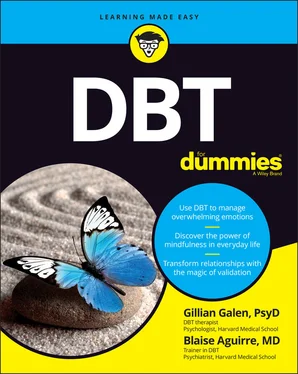As you learn to branch out and pay attention to your mind and body, and you begin to make choices based on the signals your body is sending you, you’ll almost certainly make mistakes. But here is the great news : They are your mistakes. The DBT therapist works with patients in a way that they are rewarded for trying and not punished for making mistakes. There can be no learning without making mistakes, and it is in making them and then realizing what went wrong that patterns can be corrected. Another vicious cycle happens when the fear of making any mistake prevents us from even trying, and that in turn can lead to more mistakes when a decision-making situation arises. The task is to begin to trust both your successes and errors along the way. Even trust your mistakes because you never know where a mistake might take you.
One of the risks that sensitive people face when learning to trust themselves is that they will be judged. How can you trust what you are thinking about yourself? Are you filtering your decisions through how you think others will respond? The truth is that most of the people in your life are probably so caught up in their own lives that they barely have time to go around judging you, even if it feels like that is what they are doing. As long as you care more about the opinions of the people in your life, you’ll dismiss your own, just as valid, opinions.
Altering your behavior to please others is inconsistent with self-trust. Although it might temporarily feel good, if other people weren’t true to themselves and altered their behavior to please you, how would you ever know if they were being honest?
 By being present in the moment through the practice of mindfulness, and being present to the emotions, thoughts, and sensations that your body is broadcasting, you tune into your inner wisdom, and there is no more powerful a tool to get to self-trust.
By being present in the moment through the practice of mindfulness, and being present to the emotions, thoughts, and sensations that your body is broadcasting, you tune into your inner wisdom, and there is no more powerful a tool to get to self-trust.
Part 2
IN THIS PART …
Recognize how strong emotions can lead to unhelpful behaviors.
Replace unhealthy behaviors with more helpful alternatives.
Notice how judgmental assumptions can lead to poor self-worth, and use thinking skills to address situations in healthier ways.
Improve your relationships with others by improving your relationship with yourself.
Chapter 5
Understanding Your Emotions
IN THIS CHAPTER
 Noticing and naming your emotions
Noticing and naming your emotions
 Letting go of emotional suffering
Letting go of emotional suffering
 Identifying challenging emotions
Identifying challenging emotions
Being able to identify and label your emotions is the first step in understanding and making sense of your experience. This is really the first piece of the puzzle of integrating DBT into your life. It isn’t uncommon for people to readily be able to identify the general state they are in, such as feeling overwhelmed, stressed, upset, good, or bad; however, for you to better understand your emotions, your description of how you feel must be much more precise. Furthermore, a precise description of your emotions will help you identify which DBT skills will be most effective in achieving your goal of increasing, decreasing, changing, or tolerating and accepting your emotions.
Many people come to DBT troubled by the intensity of their emotions. We have been asked by patients if we could simply make their emotions go away because the impact of their emotional sensitivity or reactivity has been so destructive to their lives that they believe living without emotions would solve the problem. If you’ve suffered this way, it’s an obvious conclusion to draw; however, living without emotions would be hugely problematic. Emotions have functions, and when they are effectively regulated, they provide us with critical information. It’s generally understood that emotions have three functions: to communicate to yourself, communicate to others, and motivate action. Think about how many interactions, decisions, and even thoughts are impacted by how you feel in a single moment.
In this chapter, you discover the value of increasing your emotional vocabulary. You find out how to identify and label your emotions, turn up and down the intensity of your emotions, and begin to pay specific attention to particular emotions that you may find challenging. Learning all of this will help you suffer less. Our hope is that in time and with practice, you can learn to love your emotions, even the ones that cause you pain.
Recognizing How You’re Feeling
The first step to recognize how you’re feeling is to pay attention. However, for people who struggle with intense emotions, the urge is to do just the opposite. Instead of paying attention, they tend to do things to avoid their emotions. Emotional avoidance can take many forms, from distracting yourself and never returning to the feeling, to telling yourself you should not or cannot feel that way, to using alcohol or drugs, sex, reckless behaviors, self-injury, or even suicide.
 If you can pay attention to what you’re feeling and shine a light on the experience, as challenging as it may be, it will actually begin the process of decreasing the intensity of that feeling. It’s a big ask, we know. Sometimes your emotions will be too intense to start observing; when that is the case, you’ll start by using distress tolerance skills (discussed in Chapter 11) to decrease the intensity of the emotion before looking more closely at how you’re feeling. It can be tempting to stop after using a distress tolerance skill, but when you do, you’re providing a short-term solution to get you through, but not creating any enduring change in how you feel.
If you can pay attention to what you’re feeling and shine a light on the experience, as challenging as it may be, it will actually begin the process of decreasing the intensity of that feeling. It’s a big ask, we know. Sometimes your emotions will be too intense to start observing; when that is the case, you’ll start by using distress tolerance skills (discussed in Chapter 11) to decrease the intensity of the emotion before looking more closely at how you’re feeling. It can be tempting to stop after using a distress tolerance skill, but when you do, you’re providing a short-term solution to get you through, but not creating any enduring change in how you feel.
In the following sections, you begin to see how paying attention and using mindfulness will help you get to know your emotions and give you the power to control them. Recognizing your emotions takes practice, but once you’re familiar with the process, you’ll find that you can easily integrate it into your life in a way that will support your use of all of the other DBT skills in this book.
Distinguishing between primary and secondary emotions
One of the most frequent questions we get when we ask people to begin to pay attention to their emotions is how to do that. It does sounds daunting and abstract, especially if we are asking you to pay attention to something that you experience as aversive. Before you can pay attention to what you feel, you first need to know what you are looking for and how you would label it. The following sections discuss how to identify both primary and secondary emotions.
 As you may have guessed from their name, primary emotions are the ones that you feel first. You can think of them as the first emotion that your brain produces after a specific prompt, an internal or external experience that creates the need for an emotion. Primary emotions are hard-wired and often have associated facial expressions that you can see across many cultures. (Note that one of the functions of emotions is to communicate to yourself and others.) In the field of study of emotion regulation, there is much debate about the number of primary emotions; some researchers believe there are four, five, eight, or ten. Dr. Marsha Linehan, the creator and founder of DBT, believes there are ten primary emotions; these are the ten that we will want you to keep an eye out for:
As you may have guessed from their name, primary emotions are the ones that you feel first. You can think of them as the first emotion that your brain produces after a specific prompt, an internal or external experience that creates the need for an emotion. Primary emotions are hard-wired and often have associated facial expressions that you can see across many cultures. (Note that one of the functions of emotions is to communicate to yourself and others.) In the field of study of emotion regulation, there is much debate about the number of primary emotions; some researchers believe there are four, five, eight, or ten. Dr. Marsha Linehan, the creator and founder of DBT, believes there are ten primary emotions; these are the ten that we will want you to keep an eye out for:
Читать дальше

 By being present in the moment through the practice of mindfulness, and being present to the emotions, thoughts, and sensations that your body is broadcasting, you tune into your inner wisdom, and there is no more powerful a tool to get to self-trust.
By being present in the moment through the practice of mindfulness, and being present to the emotions, thoughts, and sensations that your body is broadcasting, you tune into your inner wisdom, and there is no more powerful a tool to get to self-trust. Noticing and naming your emotions
Noticing and naming your emotions










